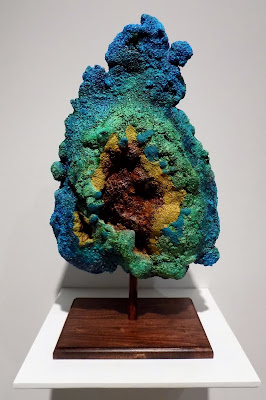Peridium #1
Accretion #1
2014
3' Diameter, Approx: 3' tall
Green Internode #1
Green Internode #1
Mixed Media
2014
Strombus #1
Crenate #1
Crenate #1
2016
3' length, 8' wide, 1' depth.
Materials used: Cardboard, paint, dye, sand, oatmeal, plaster. Wood base.
Crenation is derived from modern Latin, crenatus which means 'scalloped'. An example of an object being crenated is a leaf which has a notched edge.
Fungal Bloom
Polyp #1
Peridium #1
2015
30" in diameter with a depth of approximately 32".
Materials used: Up-cycled egg cartons, paint, dye, salt, sand, plaster, and model railroad gravel.
Accretion #1
Accretion #1
Mixed Media2014
3' Diameter, Approx: 3' tall
Accretion is a natural process by which something grows or is added to by either natural occurrences or by external addition. Accretion #1 consists of approximately 800 - 1000 individual cardboard pieces which have been fire sculpted, then painted and sprinkled with dyed salt and oatmeal. Plaster was also added to some of the pieces.
Green Internode #1
Green Internode #1
Mixed Media
2014
3' Diameter
Nodes are plant structures which hold buds that grow into one or more leaves, conifer cones, roots, stems, or flowers. Internodes are the in between structures that distance one node from another. Green Internode #1 was inspired by the natural structures called internodes that are readily found in many plant structures. This piece consists of hundreds of individual cardboard pieces that have been fire sculpted, painted, and sprinkled with dyed salt and oatmeal to create an organic looking sculptural piece. Sprouting out of the tops of many of the individual pieces are various buds which consist of dyed and painted cotton swabs, cotton swab sticks, polyfil, and paper.
Strombus
Strombus #1
Strombus #1
2016
Approximately 3' in length, 1 1/2' wide, and 1 1/2' in depth.
Materials used: Cardboard, paint, dye, and cotton swabs.
Crenate #1
Crenate #1
2016
3' length, 8' wide, 1' depth.
Materials used: Cardboard, paint, dye, sand, oatmeal, plaster. Wood base.
Crenation is derived from modern Latin, crenatus which means 'scalloped'. An example of an object being crenated is a leaf which has a notched edge.
Fungal Bloom
Fungal Bloom
2016
Approximately 1 1/2' tall, 1' wide, and 8" in depth.
Materials used: Styrofoam, paint, dye, oatmeal, sand, and plaster.
Fungal bloom was the result of a fortuitous accident while experimenting with Styrofoam filled balloons. I let a Styrofoam filled balloon sit out over night not noticing until the next day that there was a small hole in the balloon. Slowly, over the course of a day or so, the contents of the balloon leaked out creating this form. The hole in the middle is where the balloon once sat.
Polyp #1
Here are some pictures of Polyp #1.

Polyp #1
Mixed Media
2010
4' x 6'
A sedentary animal characterized by a fixed base, column like body, and a free end with mouth and tentacles. Polyps tend to be cylindrical in shape and elongated along the axis of their bodies.
The external form of the polyp varies from species to species. The column may be long and slender, or may be short, causing the body to appear almost disk‑like. The tentacles at the ends of the column, may be long and threadlike, or short, looking more like knobs or warts. The tentacles may be simple and un-branched, or their patterns may appear feathery.
Polyps tend to reproduce asexually by the method of budding. In many cases the buds do not separate from the parent but remain in continuity with it, forming colonies which can grow quite large. Minute differences in the method of budding create the variations witnessed in the colonies. The reef‑building corals are an example of polyp colonies.
Materials used:
Various tubes such as: toilet paper tubes, paper towel tubes, gift wrapping tubes, etc.
Epsom salt, table salt, oatmeal. Acrylic paint and various fabric dyes. Various types of yarn, fabric softener sheets, cotton fill, cotton swabs, and various other pieces of fabric. Also used are paper, tissue paper, and plaster.
Brown and Rust Polyp #1
Brown and Rust Polyp #1
Mixed Media: Cardboard tubes, paint, dye, salt, oatmeal, cotton swabs.
2011
2' x 2'
Orange Polyp #1
Orange Polyp #1
Mixed Media: Cardboard tubes, paint, dye, salt, oatmeal, cotton swabs.
2011
2' x 2'
Blue and Violet Polyp #1
Blue and Violet Polyp #1
Mixed Media: Cardboard tubes, paint, dye, salt, plaster, fabric, cotton swabs, pieces of egg cartons, and, oatmeal.
2012
2' x 2'
Purple, Blue, Green Polyp #1 (small)
Purple, Blue, Green Polyp #1 (small)
Mixed Media
2013
Approx: 3' long, 2" wide.
Materials used: Rolled construction paper, paint, dye, salt, oatmeal, cotton swabs, cotton swab sticks, plaster, polyfil, various fabrics, and yarn.
Polypore #1
Polypore #1
2016
Approximately 3' tall, 1 1/2' wide, and 2' in depth.
Materials used: Styrofoam, paint, dye, sand, oatmeal, plaster, cotton swab sticks, polyfil, wire, yarn, and twine.















































+1.jpg)
+5.jpg)
+9.jpg)
+11.jpg)


Some day I hope to convert the entire inside of a building to look like one of the above pieces.
ReplyDelete